— July 27, 2017
According to Google, each ad group in your AdWords account should contain at least 15 to 25 keywords. But today, we’re going to do something a little bit controversial… We’re going to disagree with Google.
In fact, we’re even going to go so far as to say that using so many words in your ad groups is a really bad idea. Why? Keep reading to find out.
What’s a SKAG?
When it comes to AdWords, we’re big believers in the Single Keyword Ad Group—otherwise known as a SKAG. It’s pretty much what you might’ve inferred from the name: an ad group that contains just one keyword. But, there’s a bit more to it than that.
Don’t worry, Avril. It’s actually not quite that complicated.
Using just one keyword per ad group is a highly granular approach that allows you to better monitor and adjust your AdWords campaigns. For instance, you’ll have much more control over whether or not your keywords align with the search terms for which you’re getting charged.
It’s important to note, however, that even with a just one keyword in your ad group you can still have multiple match types. For instance, let’s say your keyword is “women’s shoes.”

Broad Modified: +women’s +shoes, e.g. women’s red shoes
Phrase: “women’s shoes,” e.g. Where to buy women’s shoes
Exact match: [women’s shoes]
In this example, your root keyword for your SKAG would be “women’s shoes,” but your ad would still be triggered for search terms that include the keyword for these match types.
Better Control with Negative Keywords
Now, even though you have just one keyword per ad group, you can have numerous negative keywords. Negative keywords are keywords that you don’t want to trigger your ad. For example, if our women’s shoe store doesn’t sell pumps, we’d add “pumps” as a negative keyword so that we don’t waste money on people looking for a product we don’t offer.
But negative keywords aren’t just for weeding out irrelevant searches. They can also help you make sure that customers find the ad that’s best suited for them. For example, say we have two ad groups: one for “women’s shoes” and one for “vintage women’s shoes.” Why pay to show our regular women’s shoes ad to people who are interested in vintage women’s shoes? Instead, we can ensure that they see the one that is most relevant to their interests by adding “vintage” as a negative keyword in the “women’s shoes” ad group.
More Accurate and Specific Ad Copy
Because we’re using just one keyword per ad group, we can write super specific ad copy that will best appeal to searchers. This is because we don’t have to worry about writing something generic that will fit with a multitude of keywords stuffed into one ad group. Be sure to use this to your advantage and place the keyword in the headline, display URL, and the description (body) of your ad. Just take a look at this car cover ad using the keyword “BMW car covers.”

And guest what’s going to happen once every ad contains the keyword that the searcher is looking for? Your click-through rates are going to start booming. In fact, using SKAGs is a great way to achieve better quality scores. This is because the more relevant your ads are to users, the better Google will “think” of them.
Sound Good? Ok, Here’s How You Can Create Your Own SKAGs
Before you can start creating your SKAGs, you’ll first need to come up with your keyword list.
For example, let’s say we sold off our women’s shoes store and opened up golf shop. Some of our keywords might be:
- golf shop
- golf store
- golf products
You can expand your list by looking for other synonyms, (e.g. golf company).
Next, go into AdWords Editor, download your account, and then add your keywords. It’s best to use broad, phrase, and exact match for each keyword. For example, our first keyword above would be laid out like this:
- +golf +shop
- “golf store”
- [golf store]
Using these three match types will help you reach people who are interested in your products without having to search for an exact phrase. They’ll be able to add words in between or before or after and still trigger your ad.
Once you’ve added all your keywords, you’ll need to set up your bids. To start, you can set them all at the same amount and then adjust them later on according to their performance.
And then, finally, it’s time to create your ads.
Bear in mind, you’ll need to add the corresponding keyword to the headline, display URL, and the description in order to maximize your chances of a click. If people don’t see the term they searched for (especially in the headline), they’ll probably skip over to the next result. Also, make sure that your headlines don’t exceed 60 characters (combined), or else they may be truncated by Google.
Bonus tip: You can save yourself a little time by cloning ad groups and editing them for different keywords.
Next Step, Optimization
When you have too many keywords in one ad group, it can be difficult to figure out what needs to be changed in order to improve performance. That’s why SKAGs are so great. Everything is separated nice and clearly so that you can easily find areas for improvement.
You can check your search term report to see what kinds of search terms are triggering your ads. Not only will this help you make sure that your ad is being shown for relevant searches, but it also helps you identify new opportunities for negative keywords. For example, we may find that people have been searching for “miniature golf shop,” which doesn’t apply to our business. In that case, we could add the word “miniature” as a negative keyword.
But the best part of looking at your search terms report is that you may find new SKAG keywords. For example, say a bunch of people are searching for “discount golf shop.” We could create a new SKAG with “discount golf shop” as the root keyword. This way, we could have a search ad that highlights our great prices and points the searcher to a landing page with a coupon or other special offer. Just be sure to add this as a negative keyword in your other SKAGs.
Not convinced? Just don’t want to read so much? Here’s our short list of the top 5 reasons to use SKAGs

- Higher Click-Through Rates: Using one keyword per ad group means that your ads will be as relevant as possible to the user’s search term. Thus, it’s much more likely that they’ll click on your ad.
- Better Quality Scores: Because more people will be clicking on your ads and because they’re likely to stick around on your now highly relevant landing page, Google will give your quality score a boost.
- Better Account Structure: When you have just one keyword per ad group, it’s much easier to figure out where keywords should go because you don’t have to group them by themes.
- Improved Ad Position: When your CTRs and quality scores start to rise, so will your ad position—even if you’re bidding less than your competitors are. This is because Google rewards high-quality content.
- You’ll Pay Less
Guess what—improved quality score also means you don’t have to pay as much for First Page Bids (FPB). This is because Google will give you a boost just because your ads and content provide users more value.
Final Takeaways
Using single keyword ad groups is a great way to give you more control over your AdWords campaigns, including your budget. If you’re looking for a way to give your CTRs and quality scores a real boost, this is your rocket fuel.
Digital & Social Articles on Business 2 Community
(77)








